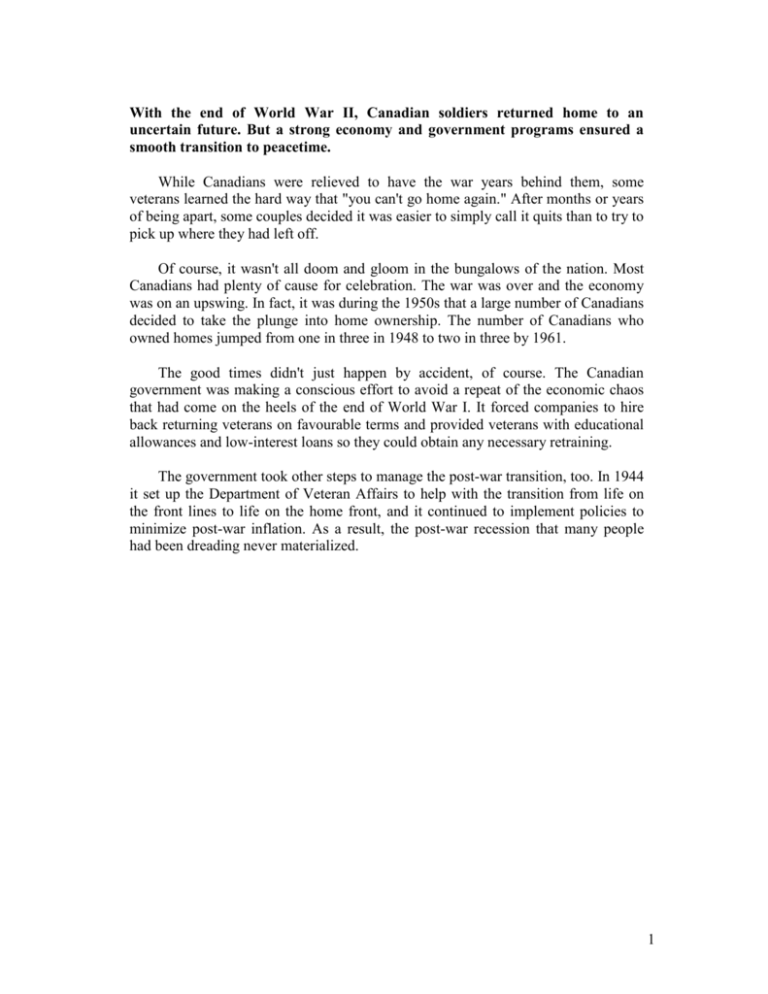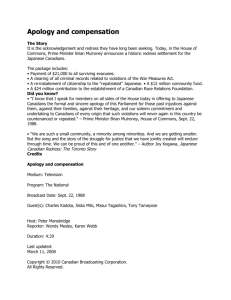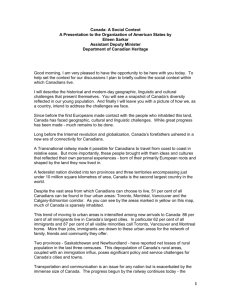CHC - Can Themes - Pol Soc & Econ Change in Can Post WWII.doc
advertisement

With the end of World War II, Canadian soldiers returned home to an uncertain future. But a strong economy and government programs ensured a smooth transition to peacetime. While Canadians were relieved to have the war years behind them, some veterans learned the hard way that "you can't go home again." After months or years of being apart, some couples decided it was easier to simply call it quits than to try to pick up where they had left off. Of course, it wasn't all doom and gloom in the bungalows of the nation. Most Canadians had plenty of cause for celebration. The war was over and the economy was on an upswing. In fact, it was during the 1950s that a large number of Canadians decided to take the plunge into home ownership. The number of Canadians who owned homes jumped from one in three in 1948 to two in three by 1961. The good times didn't just happen by accident, of course. The Canadian government was making a conscious effort to avoid a repeat of the economic chaos that had come on the heels of the end of World War I. It forced companies to hire back returning veterans on favourable terms and provided veterans with educational allowances and low-interest loans so they could obtain any necessary retraining. The government took other steps to manage the post-war transition, too. In 1944 it set up the Department of Veteran Affairs to help with the transition from life on the front lines to life on the home front, and it continued to implement policies to minimize post-war inflation. As a result, the post-war recession that many people had been dreading never materialized. 1 During the post-war years Canadians were in the mood to shop. Televisions, dishwashers, cars and houses topped their wish-list. After World War II, many Canadians finally had money to go shopping: wages in the manufacturing sector doubled between 1945 and 1956 alone -- something that led to a substantial boost to Joe and Jane Canuck's standard of living. Manufacturers were only too happy to tempt suburban shoppers with a galaxy of delights -- everything from electric refrigerators to television sets to dishwashers. Owning a dishwasher in 1960s suburbia was a powerful way of letting your neighbours know that you had arrived: very few of your neighbours could make the same claim! Auto manufacturers also benefited from the post-war spending spree. Almost overnight, Canadians had moved automobiles from the luxury to the necessity category. By 1960, two-thirds of Canadian households owned one car and 10 percent owned two or more vehicles. Housing construction also went through the roof, thanks to governmentguaranteed mortgages, veterans-housing grants, and an explosion in consumer credit. During the 1950s alone, $60 million of new housing was built -- more than twice as much as had been constructed during the previous 25 years. Of course, not everyone was willing or able to partake in this orgy of spending. Most rural Canadians could only dream of owning all the flashy gadgets that their suburban counterparts usually took for granted. Those Canadians who insisted on comparing themselves to their American counterparts had cause to be jealous: in 1950, Canadian per-capita income continued to lag a full 40 percent behind the corresponding figure in the United States. 2 It's no wonder that disposable diapers and stretchy sleepers were invented during the early 1960s. North America had just experienced the mother of all baby booms. Demographers generally agree that the baby boom years in Canada occurred between 1945 and 1960. While just 227,000 babies were born each year in Canada during the years leading up to World War II, more than twice that many were born each year during the late 1950s -- the peak years of the baby boom. Not surprisingly, the baby boom made an immediate impact on Canadian society. The population explosion sparked the creation of bedroom communities surrounding the country's major cities -- something that would leave the so-called baby boomers with both fond and not-so-fond memories of growing up in suburbia. It also led to a school construction boom that had more than a few school board officials wondering where the money to pay for all these new buildings was going to come from. By the early 1960s, however, the baby boom was fading. The birth control pill had landed on the market at the start of the decade. By the time Centennial Year rolled around, the baby boom had finally gone bust. 3 The baby boom necessitated the construction of large numbers of schools during the 1950s and led to the educational reforms of the post-war years. By the mid-1950s, Canada was spending nearly $200 million a year on building new schools. The construction boom lasted well into the 1960s. (As at least one historian has noted, it was a rare baby boomer that didn't get the opportunity to spend at least part of his or her growing up years attending classes in a brand-new school!) As the boomers aged, there was also a demand for post-secondary education. More so than their parents, boomers faced the prospect of being unemployed if they lacked some post-secondary training. The growing demand for skilled workers led to a tenfold increase (between 1951 and 1986) in the number of Canadians with university degrees. While the post-war years were a time of rapid educational reform regardless of what part of Canada you lived in, the changes were most dramatic in Quebec. Beginning in 1964 (the year the Quebec government created the Ministry of Education), it was the state rather than the Roman Catholic Church that determined what the next generation of students would learn. Gone forever were the days when the curriculum was designed to provide boys with a background in the classics and girls with training for their future roles as wives and homemakers. Quebec's Quiet Revolution had slammed the door on that traditional approach to education. 4 In 1967, the Royal Commission on the Status of Women was formally established. It was an important moment during a long-term shift in both government policies and societal attitudes to women. Liberation was the catchword of the 1960s and, like members of other traditionally marginalized groups, women began demanding equal rights. It is hardly coincidental that the women's movement gained renewed energy at the very time that the birth control pill was making it possible for women to plan their reproductive lives. In 1966, the Committee for the Equality of Women was formed under the leadership of Laura Sabia, president of the Canadian Federation of University Women. It began lobbying the federal government for the creation of a Royal Commission on the Status of Women. After Sabia threatened to march two million women to Ottawa to ensure that the group's demands were taken seriously, Prime Minister Lester B. Pearson agreed to the group's demands. The Royal Commission on the Status of Women was formally established in February of 1967. Its mandate was simple: "to inquire and report upon the status of women in Canada, and to recommend what steps might be taken by the Federal Government to ensure for women equal opportunities with men in all aspects of Canadian society..." In 1970, the Commission tabled its report, which called for a complete rethinking of attitudes and policies towards women. The Trudeau government responded, most notably by appointing a Minister Responsible for the Status of Women and establishing the Canadian Advisory Council on the Status of Women. The battle for equal rights was also fought on the home front. Women began demanding more help with housework and childcare, a modernization of the country's divorce laws, improved access to childcare, and more generous maternity benefits. They also began re-entering the workforce in large numbers. By 1981, more than half of married women held paid jobs (though they still were paid less than men). 5 In the post-war period, Canada's Aboriginal peoples began demanding that the government stop treating them like second-class citizens. Attitudes toward Native Canadians began to change dramatically after World War II. This was the result, in large part, of a cultural and political resurgence among Canada's Aboriginal peoples. Although the Canadian government did not recognize them as citizens, several thousand Native Canadian soldiers had served in the Canadian Army during the Second World War. They had experienced freedom from the restrictions of the Indian Act, and when they returned to peacetime life, many began to campaign for more freedom for Aboriginal peoples. Using new technologies to communicate their message, Native leaders made their demands known to the rest of Canada. In the context of this political and cultural renaissance among Canada's Aboriginal peoples and the UN Declaration of Human Rights, other Canadians began to question some long-held stereotypes about Natives, Metis and Inuit. Accordingly, the federal government began to rethink its paternalistic policies, many of them spelled out in the Indian Act. In 1951, the Indian Act was revised, giving individual Aboriginal band councils more decision-making power. In 1960, the federal government finally granted Aboriginal peoples the right to vote. And by the end of the decade, Ottawa had phased out its residential schools. But questions concerning land claims and self-government remained unresolved. In 1968, groups of dissatisfied Native Canadians joined together to form the National Indian Brotherhood -- a group mandated to speak on behalf of treatied and status Natives. 6 After World War II, African Canadians began challenging the racism that had made it difficult for them to enjoy the freedoms and opportunities of other Canadians. During the post-war years, African Canadians were determined to challenge the racist beliefs that had caused them to be treated as second-class citizens. Encouraged by Civil Rights and Black Power movements south of the border, African Canadians became increasingly assertive in their struggle against discrimination. A notable moment in Canada's Civil Rights Movement occurred in 1946. That year, the Nova Scotia Association for the Advancement of Coloured People raised funds to help Halifax beautician Viola Desmond defend herself in court after she was arrested for violating the segregated seating policies of a New Glasgow movie theatre. By the early 1960s segregation in public places and segregated schools were a thing of the past in Nova Scotia, though subtle forms of discrimination continued. In 1968, leading African-American militant Stokely Carmichael came to the defence of a group of black Haligonians who were challenging the city of Halifax's right to demolish Africville -- a century-old black suburb. The following year, a group of Nova Scotians formed the Black United Front to fight discrimination. The group managed to obtain funding from the federal government that was determined to quietly defuse what it saw as a growing militancy among blacks in Canada. (Hey, if you can't beat 'em, join 'em!) At the same time, a new generation of black leaders -- many of them recent immigrants from the West Indies and Africa -- were stepping to the forefront. The government certainly had cause for concern: in 1969 a protest organized by black students at Sir George Williams University (later Concordia University) in Montreal had resulted in the destruction of the university's computer system. The message was clear: like their counterparts south of the border, African Canadians had put Canadians on notice that they were no longer content with the status quo. 7 Between 1946 and 1972 Canada opened its doors to more than 3. 5 million immigrants -- an average of about 135, 000 per year. While we Canadians like to pride ourselves on our willingness to welcome immigrants and refugees from around the world, we haven't always been the most gracious of hosts. In the years before World War II, we were anything but welcoming to the very people who were most in need of sanctuary -- Jews fleeing Nazi persecution. Part of the problem was that a majority of Canadians wanted immigrants when it suited them economically, and they wanted people like themselves. Both Englishand French-Canadians were concerned that accepting immigrants from nonanglophone and non-francophone parts of the world would erode the country's English and French roots. Most supported the government's policy of excluding Asian and African immigrants. Most Canadians were concerned that immigrants would steal jobs away from other workers. Business leaders, however, were singing an entirely different tune. They lobbied for substantial immigration, arguing that a larger population would benefit the economy. Policy makers could not seem to agree on the number of immigrants that the country needed and where those immigrants should come from. Finally, Canada agreed to open its doors to more than 3.5 million "new Canadians" between 1946 and 1972 -- an average of about 135,000 immigrants per year. In most of those cases, however, it did so for economic rather than humanitarian reasons, extending the welcome mat to those immigrants who seemed to have something valuable to offer Canada rather than those who were most in genuine need. Nevertheless, refugees continued to be admitted, including Hungarians in the 1950s and Vietnamese in the 1970s. 8









